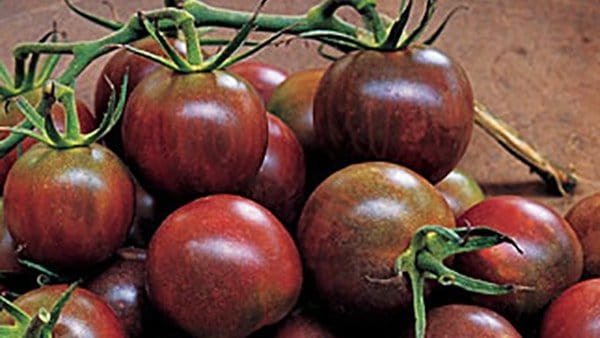
Here I go again, monitoring the tomato sweepstakes on my front walkway. I have four plants in containers, and their proximity satisfies my obsessive urge to count blossoms and tiny green fruits several times a day. Last year’s winner was grape tomato ‘Mighty Sweet’ and it’s back again, along with early fruiting ‘Fourth of July’ (I’ll be watching that date) and ‘Black Pearl’, a new entry into the competition. ‘Black Pearl’ is a vining cherry tomato with 1.5-inch (4-cm), brownish-red round fruits. The immature fruits are almost entirely brown, ripening to a dark burnished red. ‘Black Pearl’ is on the cutting edge of a new category plant breeders are calling heirloom hybrids.
Heirloom tomatoes with odd shapes, complex flavours and vivid colouring have been bred with modern hybrids to produce compact, disease-resistant plants with uniform fruit shapes. In some instances, the characteristics of several heirloom varieties are combined in a volatile mix, such as the new ‘Tye-Dye’ hybrid, a mix of genetics from ‘Big Rainbow’, ‘Pineapple’ and ‘Georgia Streak’ heirloom tomatoes, with an infusion of disease resistance and standardized growth habit from unnamed modern hybrids. ‘Tye-Dye’ has gold-and-red seven-ounce (200-g) fruits, marbled red interiors and a sweet, non-acidic flavour. Its bigger yields, consistent form and improved disease resistance surpass the performance of its heirloom gene contributors, while purportedly retaining their desirable flavour and colour characteristics.
Labelling tomatoes as heirloom is a way of categorizing plants, and can have more than one meaning. Domestic heirloom tomatoes refers to garden plants (and their saved seeds) that have been passed down through several generations of a single family. Commercial heirloom seeds are saved and field-grown from open-pollinated varieties in circulation for more than 50 years, and still available for purchase (such as my grandfather’s ‘Rutgers’ tomatoes). Spontaneous, or natural heirlooms, are tomatoes that have crossed their genetics in the garden (via wind and bees), and then been discovered and grown on from saved seed.
What’s good about heirloom tomatoes is their flavour. If you’ve tasted a slice of a deep pink ‘Brandywine’ tomato, you’ll know real tomato taste. (‘Brandywine’ has now been re-bred as the heirloom hybrid ‘Brandymaster’, available in red and yellow selections, with more uniformly shaped fruit and increased disease resistance). What’s less desirable about some heirlooms is their irregularly shaped fruit, long vines with low yields, vulnerability to diseases and thin-skinned fruit with a tendency to crack.
When plant genes are crossed in a breeding program, the intention is to enhance some characteristics and lose or reduce others. The infusion of strong modern genes is meant to result in tomatoes with the best of both categories. However, some desirable genes, such as scent genes in roses, occasionally defy efforts to harness and redirect them. I seriously hope that re-breeding heirloom tomatoes doesn’t decrease the flavour in the resulting hybrids.
I’ll be carefully watching my ‘Black Pearl’ tomato plant for signs of heirloom quality and modern vigour. ‘Black Pearl’ is bred from a combination of heirloom ‘Black Cherry’ (a dark mahogany-red cherry tomato) and modern mystery genes.
Given the choice, I’d like a perfect tomato with superior flavour, short vines, high yield, consistent fruit shape and strong disease resistance. But the bottom line is that the flavour must be there. Otherwise, I’ll settle for a more troublesome, but delicious, tomato plant.









Hi, somewhere I read that these plants produce sterile seeds. Is that true? if so, will they cross polinate my other tomatoes and make THEM sterile? Terminator seeds can do that – are these the same? If the seeds are sterile, then how can people grow seedlings of them in my home town? Wouldn’t they ahve to get seeds or plants from a special lab or something? Thanks! Rachel
I say that becuase I bought some seedlings and then looked them up and got the above information.
You’re probably right about the unlikely result of getting an identical plant from saved ‘Black Pearl’ seed. Open-pollinated heirloom genes are still prominent in ‘Black Pearl’, but it would be a mistake to assume an heirloom hybrid will reliably come true from seed. My guess is it could be an identical plant for at least one generation grown from saved seeds, and thereafter, you might get mixed results. Subsequent generations would tend back toward the ‘Black Cherry’ ancestor, or one of the unnamed hybrid genes. However, these are worthwhile options! Seeds for ‘Black Pearl’ are available from mariannasheirloomseeds.com. ‘Tye-Dye’ seeds are available from tomatogrowers.com.
Am I correct in thinking that saved seeds from these hybrids will not reproduce the same plant in the way that ordinary heirlooms will. Also, are seeds available for Black Pearl and the other varieties mentioned or only plants?